Extended heat and low rainfall across Europe are causing major rivers to dry up. This is having serious consequences for wildlife, the economy and the people living near the Rhine, Po, Thames and other affected rivers.
Date 10.08.2022
Author Carla Bleiker
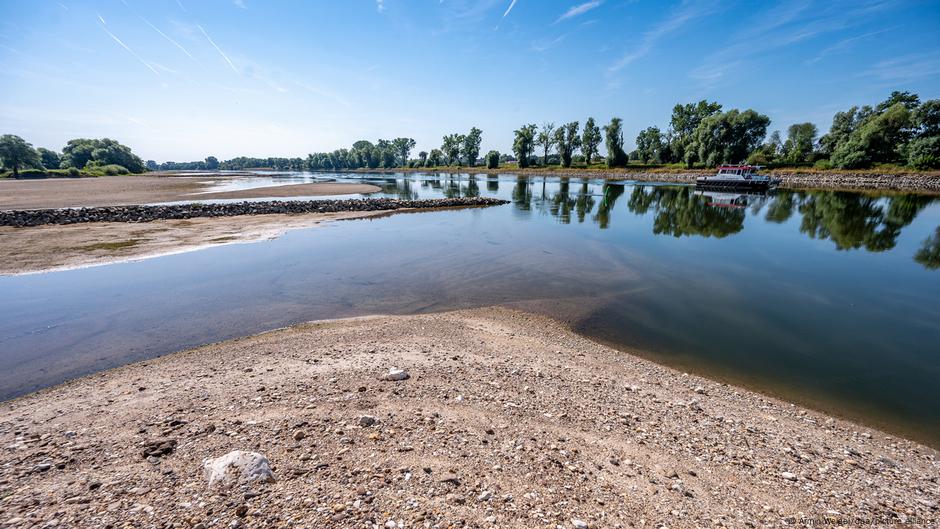
European rivers such as the Danube are dangerously low after months of drought
Europe's great rivers are important economic routes and ecosystems, as well as emblems of the cities through which they pass. Now, countries all across the continent are struggling once more with high temperatures and prolonged drought — and, as a result, the rivers are running low or are simply too hot.
The water level in the Rhine is extremely low. The average depth of the river at this time of year is usually about 2 meters (6.5 feet), but in some places it has fallen to less than 1 meter. In one narrow section of the river, near the German city of Koblenz, the water level at the start of August was only 56 centimeters (22 inches).
The Rhine is one of the busiest waterways in the world, but low levels mean severe restrictions for cargo ships. In order for them to pass through the narrow section near Koblenz fully laden, for example, the water has to be at least 1.5 meters deep. The shallow flow means they can only be loaded to a fraction of their capacity — and this pushes up the price of the goods they transport. If water levels don't rise soon, some ships won't be able to pass at all.
Author Carla Bleiker

European rivers such as the Danube are dangerously low after months of drought
Europe's great rivers are important economic routes and ecosystems, as well as emblems of the cities through which they pass. Now, countries all across the continent are struggling once more with high temperatures and prolonged drought — and, as a result, the rivers are running low or are simply too hot.
The water level in the Rhine is extremely low. The average depth of the river at this time of year is usually about 2 meters (6.5 feet), but in some places it has fallen to less than 1 meter. In one narrow section of the river, near the German city of Koblenz, the water level at the start of August was only 56 centimeters (22 inches).
The Rhine is one of the busiest waterways in the world, but low levels mean severe restrictions for cargo ships. In order for them to pass through the narrow section near Koblenz fully laden, for example, the water has to be at least 1.5 meters deep. The shallow flow means they can only be loaded to a fraction of their capacity — and this pushes up the price of the goods they transport. If water levels don't rise soon, some ships won't be able to pass at all.
WWII bomb resurfaces
When drought hits, remarkable things resurface from rivers and lakes: bones, fossils, even entire civilizations that sank beneath floodwaters thousands of years ago.
In late July, the receding water of the Po, Italy's longest river, exposed something far more dangerous when fishers near the city of Mantua found a 450-kilogram (1,000 pound) World War II bomb. It was only revealed because the northern Italian regions, including the Po Valley, are currently experiencing their worst drought in 70 years.
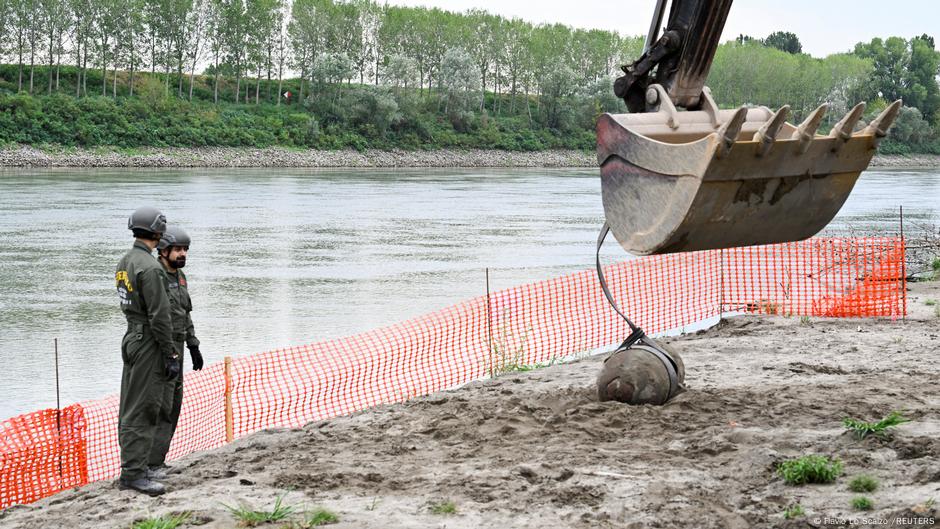
The receding waters of the Po River in Italy exposed a World War II bomb, which had to be destroyed
According to the Italian army, the unexploded bomb was defused, transferred to a safe site and detonated in a controlled explosion in early August. No one was hurt, but about 3,000 people had to leave their homes along the banks of the river during the operation.
Shifting Thames
The Thames is as much a part of London as Buckingham Palace or the Houses of Parliament, but it originates near the village of Kemble in southwest England. Or it did — until recently.
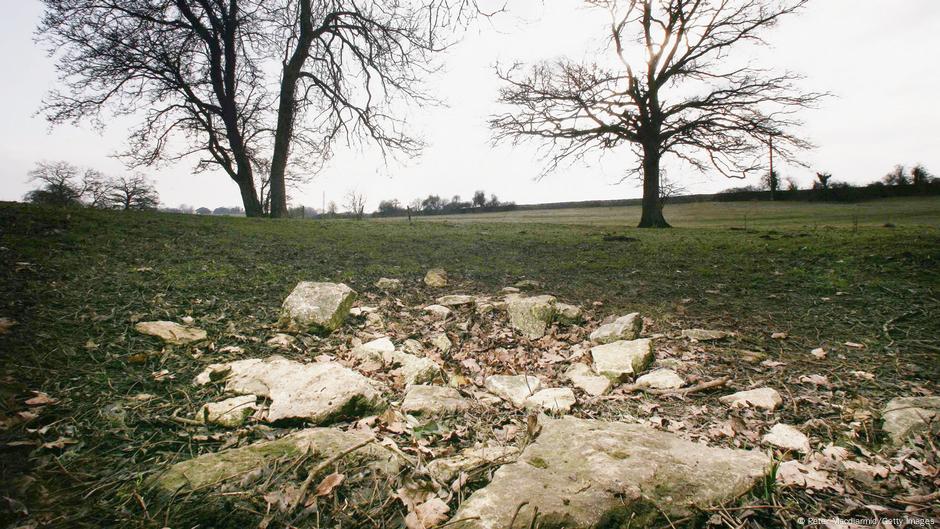
This was once the source of the Thames; the British river now surfaces 8 kilometers (around 5 miles) away
This picture shows the original source of the Thames in February 2006. That year, drought caused the source of the river to shift 1.5 kilometers (1 mile) to the southeast. This summer, conditions have gotten so bad that the Thames surfaces over 8 kilometers downstream from its official starting point.
Loire's nuclear responsibility
People associate the Loire with France's picturesque river landscapes and fairy-tale castles — but its banks are also home to the Belleville nuclear power plant.
This is no coincidence: Nuclear power plants are always situated near water because they need it for cooling. The Belleville plant discharges the water that it has used as coolant into the Loire, and refills its cooling towers with fresh water from the river.
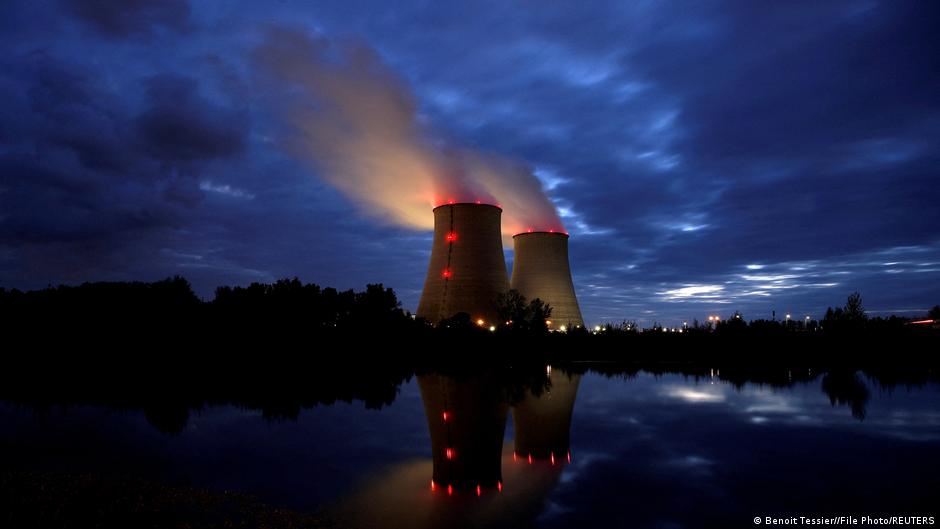
The Belleville nuclear power plant uses water from the Loire as a coolant
To protect the flora and fauna in and around the river, strict rules govern the degree to which power plants are allowed to raise the temperature of the river water. Once the maximum permitted temperature is reached, the nuclear power plants have to reduce their output — meaning they produce less electricity.
To top it off, this is occurring in a hot summer when the French are likely to have their fans and air conditioners on at full blast and Russia has stopped supplying France with gas via pipelines.
Danube's dipping oxygen
Water temperatures in the Danube are already dangerously high this summer — and water levels are low. In early August, the temperature of the river where it flows through the Upper Palatinate region of Bavaria was over 25 degrees Celsius (77 Fahrenheit) for seven days straight. The regional government there has warned that it can be expected to rise to over 26.5 degrees Celsius.
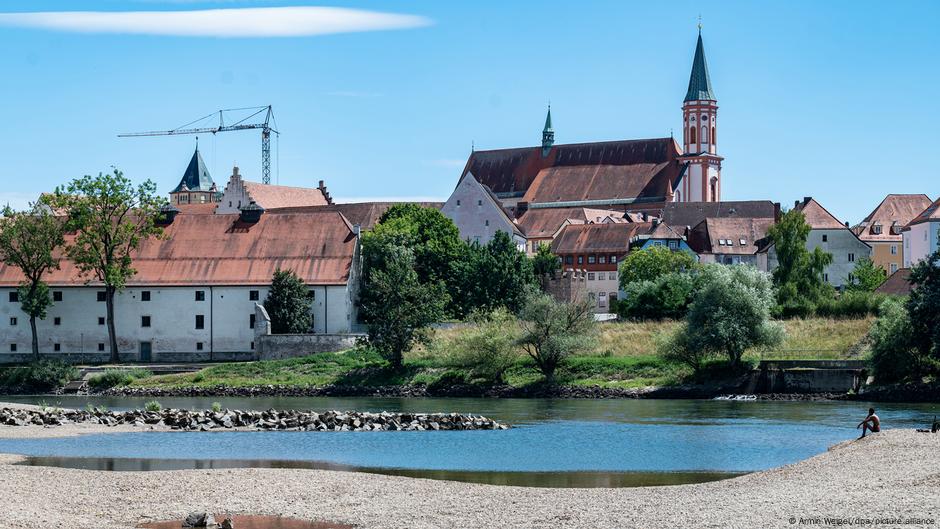
The water in the Danube — seen here near Straubing in Bavaria — isn't just very low, it's also too hot
The heat affects the oxygen content of the water, which could drop below six parts per million — a level that low would spell death for some fish in the Danube, including trout. Consequently, the district government has declared an alert level that allows it to ban dredging in the river and other measures that would worsen the ecological situation. It can also require wastewater treatment plants to suspend operations. This may be enough to save the trout.
This article was originally written in German.
Tourist boats marooned, farm land parched as drought lowers Europe's rivers


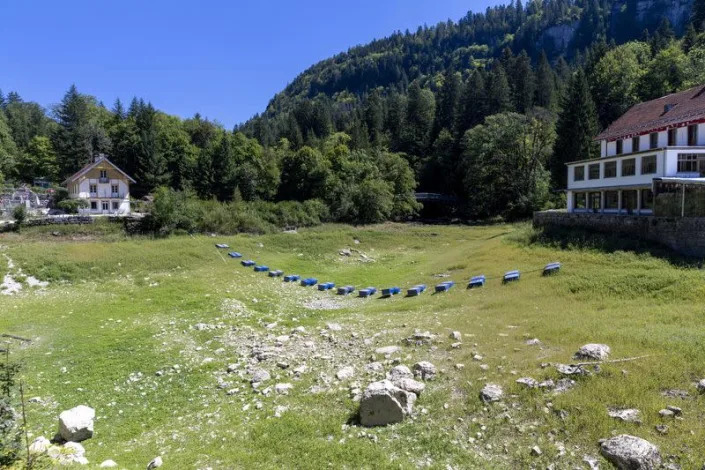



Drought affected Doubs river in Les Brenets
Tue, August 9, 2022
By Denis Balibouse
VILLERS-LE-LAC, France (Reuters) - Business for Francoise Droz-Bartholet has reduced to a trickle, just like stretches of the Doubs River straddling the French-Swiss border that her cruise boats usually ply.
Water levels in rivers, lakes and reservoirs across western Europe are running low, or even dry, amid the severest drought in decades which is putting stress on drinking water supplies, hampering river freight and tourism and threatening crop yields.
The Doubs river should coarse through a forested canyon and cascade over waterfalls before spilling out into Brenets Lake, a draw for tourists in eastern France's Jura region. After months without meaningful rain, the river water has receded up the canyon and sluggishly reaches the lake in a narrow channel.
"We hope this drought is an exception to the rule," said Droz-Bartholet, whose bookings are 20% lower than usual for the time of year.
She now has to bus clients along the gorge to a starting point further upstream to a point in the river where there is enough water for her cruise boats to navigate.
Asked how his boat tour had gone, holidaymaker Alain Foubert said simply: "It was a lot shorter than normal."
Conditions have deteriorated across Europe as multiple heatwaves roll across the continent.
In Spain, farmers in the south fear a harsh drought may reduce olive oil output by nearly a third in the world's largest producer. In France, which like Spain has had to contend with recent wildfires, trucks are delivering water to dozens of villages without water.
In Germany, cargo vessels cannot sail fully loaded along the Rhine, a major artery for freight, and along Italy's longest river, the Po, large sandbanks now bake in the sun as water levels recede sharply. In July, Italy declared a state of emergency for areas surrounding the Po, which accounts for more than a third of the country's agricultural production.
As France contends with a fourth heatwave this week, many scientists say the blistering temperatures so far this summer are line with the increasing frequency and intensity of extreme weather episodes in Europe.
Britain's weather service on Tuesday issued an amber "Extreme Heat" warning for parts of England and Wales, with no respite in sight from hot dry conditions that have sparked fires, broken temperature records and strained the nation's infrastructure.
On the Doubs River, fewer boat tourists means fewer meals to serve for restaurateur Christophe Vallier - a painful blow just as he hoped to recover from the COVID-19 downturn. And he sees little cause for hope in the future.
"All the Doubs experts say the river is getting drier and drier," Vallier lamented.
(Reporting by Denis Balibouse; Writing by Richard Lough; Editing by Susan Fenton)






Drought affected Doubs river in Les Brenets
Tue, August 9, 2022
By Denis Balibouse
VILLERS-LE-LAC, France (Reuters) - Business for Francoise Droz-Bartholet has reduced to a trickle, just like stretches of the Doubs River straddling the French-Swiss border that her cruise boats usually ply.
Water levels in rivers, lakes and reservoirs across western Europe are running low, or even dry, amid the severest drought in decades which is putting stress on drinking water supplies, hampering river freight and tourism and threatening crop yields.
The Doubs river should coarse through a forested canyon and cascade over waterfalls before spilling out into Brenets Lake, a draw for tourists in eastern France's Jura region. After months without meaningful rain, the river water has receded up the canyon and sluggishly reaches the lake in a narrow channel.
"We hope this drought is an exception to the rule," said Droz-Bartholet, whose bookings are 20% lower than usual for the time of year.
She now has to bus clients along the gorge to a starting point further upstream to a point in the river where there is enough water for her cruise boats to navigate.
Asked how his boat tour had gone, holidaymaker Alain Foubert said simply: "It was a lot shorter than normal."
Conditions have deteriorated across Europe as multiple heatwaves roll across the continent.
In Spain, farmers in the south fear a harsh drought may reduce olive oil output by nearly a third in the world's largest producer. In France, which like Spain has had to contend with recent wildfires, trucks are delivering water to dozens of villages without water.
In Germany, cargo vessels cannot sail fully loaded along the Rhine, a major artery for freight, and along Italy's longest river, the Po, large sandbanks now bake in the sun as water levels recede sharply. In July, Italy declared a state of emergency for areas surrounding the Po, which accounts for more than a third of the country's agricultural production.
As France contends with a fourth heatwave this week, many scientists say the blistering temperatures so far this summer are line with the increasing frequency and intensity of extreme weather episodes in Europe.
Britain's weather service on Tuesday issued an amber "Extreme Heat" warning for parts of England and Wales, with no respite in sight from hot dry conditions that have sparked fires, broken temperature records and strained the nation's infrastructure.
On the Doubs River, fewer boat tourists means fewer meals to serve for restaurateur Christophe Vallier - a painful blow just as he hoped to recover from the COVID-19 downturn. And he sees little cause for hope in the future.
"All the Doubs experts say the river is getting drier and drier," Vallier lamented.
(Reporting by Denis Balibouse; Writing by Richard Lough; Editing by Susan Fenton)
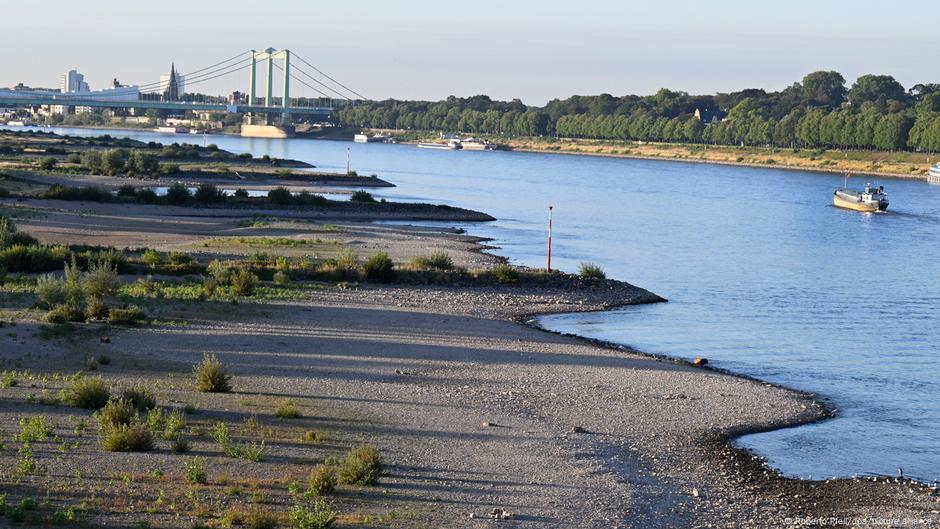
No comments:
Post a Comment